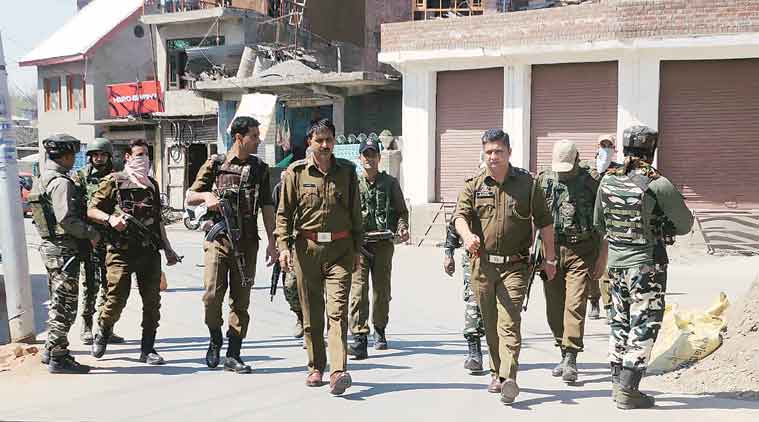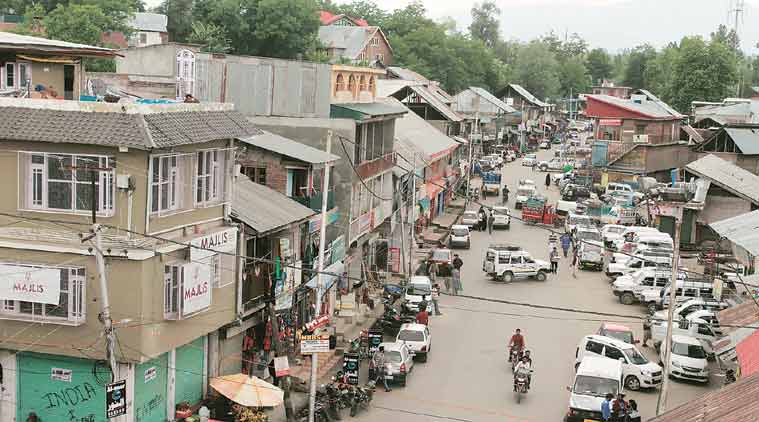The new age militant comes from a middle-class family with all the ingredients of a normal Kashmiri family. He has Hanafiya inclination and not Salafi (or Wahabi), has been educated in government schools and not madrasas. This militant is not a child from a broken family. His age is between 15 and 25 years, is unmarried, has no substantial criminal antecedents and has behaviour as normal as a guy next door. There is hardly any early indication of him being drifted towards armed militancy.”
READ | Rajnath Singh to visit J&K today, review ceasefire impact
This is how a 74-page confidential report — based on a detailed study conducted by the J&K Police’s Criminal Investigation Department (CID) — has profiled local youths in the Valley who have become militants.
READ | Local recruits & Burhan Wani’s killing: Security officials map militancy’s new patterns in the Valley
Titled “Radicalisation and Terrorism in J&K — A Study”, the CID says that the aim of the study was “to gauge the existence and extent of radicalisation in the youth of Kashmir”. The report is based on an elaborate study of “156 local youths of the Valley who have joined militancy between 2010 and 2015”.
The report says that its findings are based on the CID’s “extensive intelligence database along with detailed interviews of family members, friends, neighbours, acquaintances” conducted by a group of field officers.

The report is based on an elaborate study of “156 local youths of the Valley who have joined militancy between 2010 and 2015”.
The report has also debunked the traditional understanding of Kashmir’s militancy and sought a rethink. “One noticeable outcome of this study is that this wave of fresh recruitments is not based or driven by ideology as the surge is only seen in South Kashmir and there too in identifiable areas. If it would have been ideology driven, then pan-Kashmir footprints would have been seen,’’ says the report.
READ | Jammu and Kashmir: Encounters fuel militant hiring, says official report
“This study was done in the background of certain perceptions and notions. On analysis, we may conclude that not all of those perceptions/notions are true. For example, the perception that well-educated youth and from economically affluent families are joining militancy does not seem true. Quite interestingly and contrary to the set beliefs, he is not the product of madrasas. Majority of these militants are government school read, negating the general perception that madrasas are beds of radicalisation.”
Read | Jammu and Kashmir: Latest militant recruit could be brother of IPS officer
Questioning what it terms “revenge theory”, the report says although “it is often believed that a militant is a victim of state action, or simply placed, a youth is forced to join militancy by the state actions. Only in the 20 per cent of the cases, it emerged that they (militant recruits) had been previously allegedly harassed by security forces.”

The report has also debunked the traditional understanding of Kashmir’s militancy and sought a rethink.
The report says that opting for guns “is a youth phenomena” and youngsters “join militancy because of thrill seeker attitude”. “Most militants are between their mid-teens and mid-twenties. This is (because) the period of youthful identity formation is when individuals are most vulnerable to the attractions of networks that offer both social solidarity and a clear narrative to explain what is going on in the world.”
Read | After Ramzan ceasefire, Centre to reach out to Valley youth; seize chance, urges CM Mehbooba Mufti
The report traces the life cycle of a local militant in four stages. The first stage is where the youngster feels “disillusionment with the status quo, lack of opportunity and no space for dissent”. In the next stage, he “turns to religion in search of solace, tries to be with like-minded people and distances from family”. The third stage is when he “feels the need and responsibility to change the status quo, even with force, contacts militant groups and joins”. The final stage, the report says, is the “vicious circle” when he (the militant) “gets killed, is turned into a martyr by stakeholders, becomes a hero for other disillusioned youth, completing the circle”.
Consider some examples from the confidential report:
* 32 per cent of youths who joined militancy had passed Class X. 19 per cent were undergraduates and graduates while post-graduates constitute 7 per cent. The remaining 7 per cent were without any education.
* Nobody had studied in a full time Madrasa. 74 per cent had never visited Darsgah or Madrasa for any formal education.
* 56 per cent had studied in government schools, 34 per cent had studied in both government and private schools, 6 per cent had studied in private schools.
* 90 per cent of the 156 militants were unmarried.
* Only 8 per cent had some gainful employment.
* 72 per cent had no criminal background
* 71 per cent were Hanafiya in their religious inclination. Only about 3 per cent were Salafi and about 23 per cent had Jamaat-i-Islami leanings.
* Only 8 per cent of recruits were also stone pelters.
* 65 per cent showed religious inclination before joining militancy while 10 per cent were academically inclined. 3 per cent were drug addicts and 22 per cent were vagabonds.
* 23 per cent had first became Over Ground Workers (OGW) before joining militant ranks. Of these, half joined militancy within a year.
* Out of the 156 militants, 19 per cent were detained before joining militancy, 4 per cent were in detention for 6 months, 7 per cent detained for between 6 and 12 months, another 7 per cent between 1 to 5 years. One percent had been jailed for more than five years before becoming a militant.
* Around 15 per cent had either a family member, relative or a close friend killed in counter-insurgency action.
* 19 per cent reported having been occasionally arrested, beaten and harassed (by police or security forces).
* 5 per cent had suffered some kind of collateral damage to their property during counter-insurgency operations.
* 25 per cent of youths had access to social media in 2010 and 2011 which rose to 30 per cent by 2014 and and 70 per cent in 2015.
* Out of the 156 militant recruits, 81 per cent lived in areas which had active local militants already present in the area.
* 21 per cent had a monthly family income between Rs 10,000 and Rs 20,000, 23 per cent had between Rs 5,000 and Rs 10,000, 21 per cent had below Rs 5,000. Only 4 per cent had a family income of more than Rs 50,000.